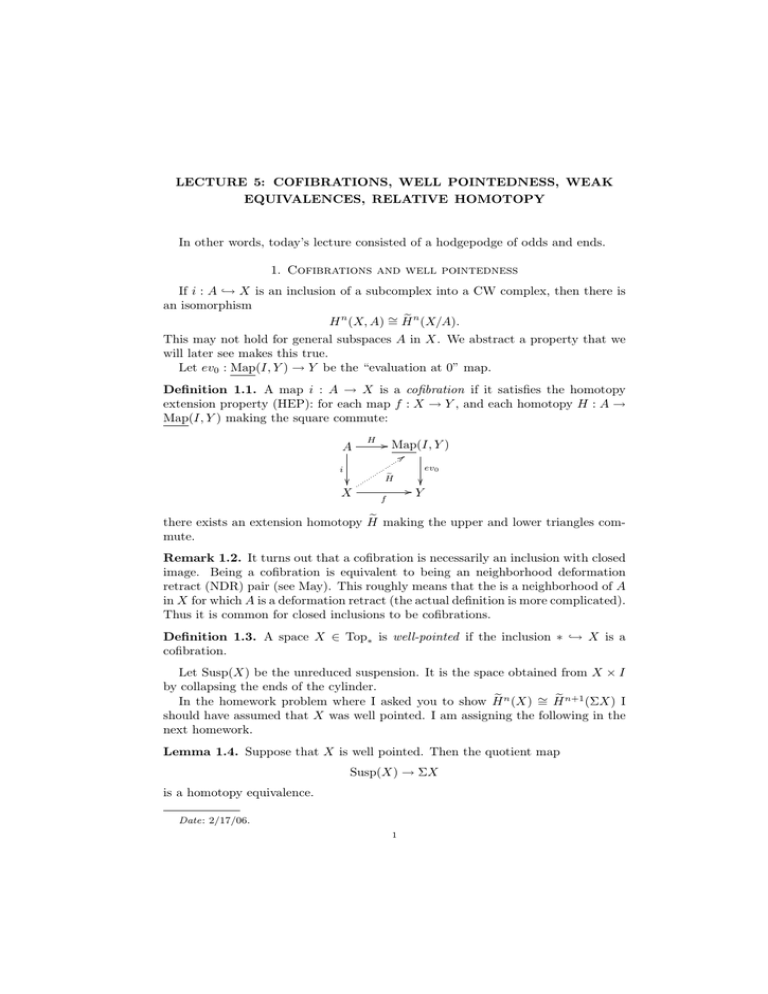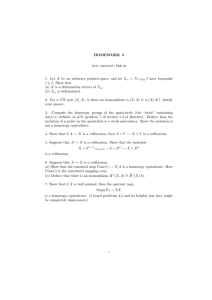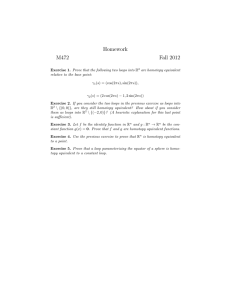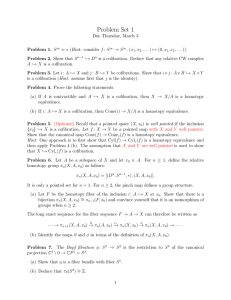LECTURE 5: COFIBRATIONS, WELL POINTEDNESS, ... EQUIVALENCES, RELATIVE HOMOTOPY
advertisement

LECTURE 5: COFIBRATIONS, WELL POINTEDNESS, WEAK
EQUIVALENCES, RELATIVE HOMOTOPY
In other words, today’s lecture consisted of a hodgepodge of odds and ends.
1. Cofibrations and well pointedness
If i : A �→ X is an inclusion of a subcomplex into a CW complex, then there is
an isomorphism
� n (X/A).
H n (X, A) ∼
=H
This may not hold for general subspaces A in X. We abstract a property that we
will later see makes this true.
Let ev0 : Map(I, Y ) → Y be the “evaluation at 0” map.
Definition 1.1. A map i : A → X is a cofibration if it satisfies the homotopy
extension property (HEP): for each map f : X → Y , and each homotopy H : A →
Map(I, Y ) making the square commute:
A
/ Map(I, Y )
:
H
ev0
i
X
�
H
f
/Y
� making the upper and lower triangles com­
there exists an extension homotopy H
mute.
Remark 1.2. It turns out that a cofibration is necessarily an inclusion with closed
image. Being a cofibration is equivalent to being an neighborhood deformation
retract (NDR) pair (see May). This roughly means that the is a neighborhood of A
in X for which A is a deformation retract (the actual definition is more complicated).
Thus it is common for closed inclusions to be cofibrations.
Definition 1.3. A space X ∈ Top∗ is well­pointed if the inclusion ∗ �→ X is a
cofibration.
Let Susp(X) be the unreduced suspension. It is the space obtained from X × I
by collapsing the ends of the cylinder.
� n (X) ∼
� n+1 (ΣX) I
In the homework problem where I asked you to show H
= H
should have assumed that X was well pointed. I am assigning the following in the
next homework.
Lemma 1.4. Suppose that X is well pointed. Then the quotient map
Susp(X) → ΣX
is a homotopy equivalence.
Date: 2/17/06.
1
Not every pointed space is well pointed. However, if a pointed space X is not
well pointed, we can form a new “whiskered” space Xw = X ∪{0} I where we glue
an interval to the basepoint. We give Xw the basepoint {1}. You will verify:
• The inclusion X �→ Xw is a deformation retract.
• Xw is well pointed.
2. Weak equivalences
The action of the fundamental groupoid on the higher homotopy groups is de­
scribed by a functor
πk (X, −) : πoid (X) → Groups.
In particular, because πoid (X) is a groupoid, a path γ from x to y must induce an
isomorphism
γ∗ : πk (X, x) → πk (X, y).
Definition 2.1. A map of spaces f : X → Y is a weak homotopy equivalence, or
simply a weak equivalence if
(1) f∗ : π0 (X) → π0 (Y ) is a bijection.
(2) f∗ : πk (X, x) → πk (Y, f (x)) is an isomorphism for all k > 0 and all x ∈ X.
We used the action of the fundamental groupoid to prove the following proposi­
tion.
Proposition 2.2. Homotopy equivalences are weak homotopy equivalences.
3. Relative homotopy groups
Let X be pointed, and let A be a subspace of X containing the basepoint. We
define relative homotopy groups
πk (X, A) = [(I k , ∂I k , ∂I k − (I k−1 × {0})), (X, A, ∗)].
That is, maps of the k­cube which send the boundary into A, and which sent all
but one of the faces of the cube to the basepoint, up to homotopies which preserve
these conditions.
For k = 0, relative homotopy is not defined. For k = 1, relative homotopy is a
set. For k ≥ 2, relative homotopy is a group, with the group operation given by
juxtaposition of cubes. For k ≥ 3, these groups are abelian.
Much like relative homology, relative homotopy fits into a long exact sequence:
j∗
i
∗
· · · → πk (A) −→
πk (X) −→ πk (X, A)
∂
−
→ πk−1 (A) → · · ·
· · · → π1 (X, A) → π0 (A) → π0 (X)
The end of this sequence must be interpreted appropriately, because these are just
sets: π1 (X) acts on π1 (X, A), with orbits given by the subset of π0 (A) sent to the
basepoint component in π0 (X).
2







